Planting figs in spring and autumn: terms and rules for planting seedlings in open ground
So, you want to plant figs in your area, but you don't know when and how best to do it. Indeed, growing such a thermophilic southern plant in temperate (middle) latitudes is a very interesting activity.
Next, you will learn about all the essential features of this subtropical culture, namely the timing, rules for planting and caring for figs in the open field.
By the way! Fig, fig tree, fig tree - these are all synonyms.
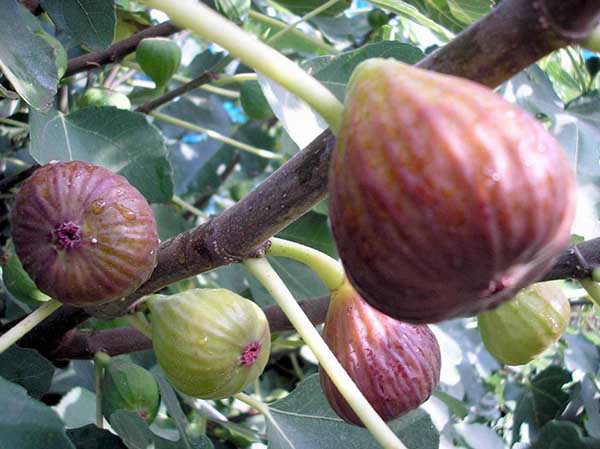
Content
Prerequisites for successful fig cultivation
Figs are a very thermophilic subtropical culture with a long growing season (200-220 days), which requires a lot of heat for normal fruiting (ripening of fruits and ripening of shoots). Namely, the SAT-sum of active temperatures (the sum of the average daily air temperatures exceeding +10 degrees) should be equal to 3500-4000 degrees.
In other words, SAT (the sum of active temperatures) of your area should allow the harvest and wood (shoots) to ripen.
Accordingly, you will hardly be able to get a full-fledged crop in the conditions of the Middle Lane (Moscow region), when grown in open ground, where the average CAT is 2000-2500 degrees.
therefore in the middle laneto get a more or less good harvest, it is better to plant and grow figs in a trench, greenhouse or greenhouse.
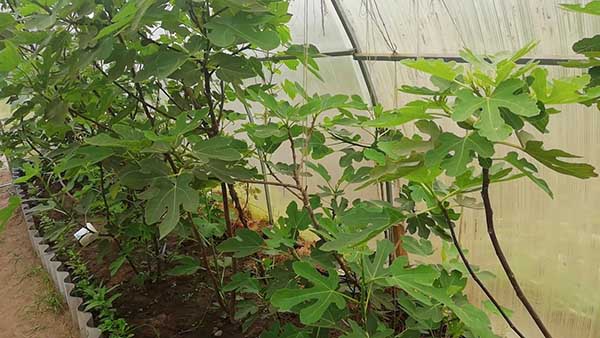
Rostov region and eastern Ukraine are much more suitable for growing figs (CAT - 3000 and more degrees).
Of course, figs can be grown with great success in the same Stavropol Territory, in the Kuban (Krasnodar Territory), in southern Ukraine, in the Crimea, where SAT is just 3500 degrees or more. Moreover, the most ideal conditions are the southern coast of Crimea and the Black Sea coast of the Kuban.
Interesting! Figs can give two harvests per season: the first (on last year's shoots) - in the summer (larger), the second (on new shoots) - in the fall.
However, this is the case under normal growing conditions and proper shelter, but under the conditions of the Middle Lane, you will only be able to ripen one crop.
Advice! If the second crop does not have time to ripen, then the figs can be covered along with its pea-shaped fruits. This will be your first harvest next year.
When does figs begin to bear fruit?
As a rule, already in the second year after planting.
Can I grow in a pot at home
Figs can be grown as a pot crop. You just need pots of sufficient capacity (at least 10 liters), almost any substrate (ordinary garden soil will do) and the ability to create a dormant period for the fig in winter (after it sheds its leaves in November). Namely, keep it for 3 months (from December to February) in a cool place - a cellar or basement.
As for the growing conditions, then, as already mentioned, figs are warm and light-loving, so it must be placed on the southern windowsill. It also adapts well to dry room air.
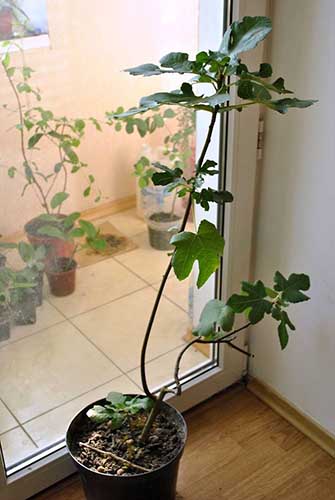
Video: how to grow figs at home
When to plant figs in spring and autumn: optimal timing
Figs can be planted both in autumn and spring.
- If you decide to plant figs in the fall, then this must be done 3-4 weeks before the onset of frost, i.e. around September-October.
- If in the spring, then after spring return frosts, i.e. not earlier than May in the Central lane and April in the southern regions.
As for when it is better to plant - in spring or autumn, most gardeners are still inclined to believe that it is better to plant figs in spring, so that it can take root well and adapt in a new place during the season, because when planting in autumn, a young seedling can simply freeze out (even under good cover) or dry out (due to improper cover).
How to preserve a seedling in the winter if you bought it in the fall
If you purchased a seedling in the fall, or grew from a cutting, but decided to postpone planting in the spring, then you can save the seedling in one of the following ways:
- If you bought a seedling with an open root, then you need to plant it in a bucket (pot) and bring it for the winter in cool place - in the basement or cellar, where the temperature in winter does not drop below zero (plus).
- If you have grown a seedling from a cutting, then in the fall it is advisable to dig it up with a large clod of earth and also place it in a basement or cellar for wintering.
You can, of course, try to dig in the ground or cover in trenches (depending on your planting method).
Fig planting rules
Variety selection
Parameters of a suitable fig variety for growing in temperate latitudes:
- early or mid-early ripening;
- self-fertile (parthenocarpic);
Parthenocarpic = not requiring pollination.
In general, a fig is a dioecious plant in which male inflorescences grow on some trees, and female flowers on others.
- remontant (fruiting 2 times - in summer and autumn);
- frost-resistant (maximum zoned).
For example, Brunswick is such a variety.
Place on the site
Fig is a very warm and light-loving plant, in other words, an exceptionally sunny place in your garden is suitable for it. In this case, the place must be protected from strong northeast winds.
In a shaded place, figs simply cannot grow normally, and even more so, they simply cannot bear fruit (the fruits will hardly form, and those that will form will simply not have time to ripen).
Planting pit preparation
As for the size of the planting pit for figs, it should be large enough. As a rule, a hole 40 cm deep and about the same width (diameter) will be enough, maybe a little more - 50-60 cm.
However! If you are going to plant figs in a trench (pit), then in this case you will have to dig a much deeper hole, at least 60-70 cm.
Figs are considered a culture, absolutely not demanding on soil composition (can grow anywhere). But nevertheless, it is better to fill the planting hole (for early rooting) with sufficiently loose and fertile soil, and also add fertilizers (optional).
Thus, the planting hole can be filled with the following potting mix:
- humus or compost (1-2 buckets);
- deoxidized peat (1-2 buckets);
- the upper fertile layer of soil (which you have left after digging a hole);
Also, if you wish, you can add phosphoric (superphosphate or bone meal) and potash fertilizer (potassium sulfate or wood ash).
Then everything needs to be carefully mix, and then pour a small pillow (5 cm layer) of fertile soil (no fertilizer) and condense.
You should have fertile soil (garden soil + humus or compost + peat) for further filling the seedling.
Preparing a seedling for planting
If you purchased open root seedling (ACS), then immediately before planting it in the ground, it is desirable first update (trim slightly) the tips of its roots, and then dip in a clay mug (for their better contact with the ground).
With regard to preparation seedling in a pot (with ZKS - closed root system), then it is practically not required. However, often after planting, fig leaves begin to turn yellow and turn white - they get sunburn. The fact is that before planting a seedling in open ground, it is advisable to carry out hardening to accustom the seedling to direct sunlight... Therefore, begin to gradually take out the pot of seedling in the afternoon to fresh air (in the garden or on an open balcony), gradually increasing the residence time. As a rule, adaptation will take about 2-3 weeks.
Planting methods for fig seedlings
In a permanent place, seedlings can be planted in open ground (straight or obliquely), in a hole or trench, as well as in a pot (for further cultivation in room conditions).
By the way! As for the planting scheme: if you are planting several seedlings, then distance between bushes should be at least 3-3.5 meters.
Landing in the ground
- Prepare and fill the planting pit with fertile soil mixture.
- Pour a mound in the center (if you are planting a seedling with an open root system).
If you are planting a seedling in a container, then plant it on a flat surface.
- Plant a seedling. Put on a mound and spread the roots down (in no case should they look up).
- As for the planting depth, it is desirable that the seedling still be planted below ground level (in a hole). Only in this case, you can most reliably cover it for the winter, and the root system of a young seedling will definitely not freeze out.
However! You can try to plant a seedling and flush with the soil surface.
- Next, you need to cover the seedling with fertile garden soil, and then compact.
- Water abundantly (2-3 buckets). Wait until moisture is absorbed. If the earth settles heavily, then add soil.
- As a rule, immediately after planting, you need to prune the figs (for more information on how to form a young seedling, read the separate "Formation" paragraph).
Video: planting figs in spring
Inclined planting in the ground
It is not necessary to plant directly, you can plant a seedling and obliquely (at an angle of 45 degrees, like a currant); so in the future you will simplify the task of bending and covering the branches for the winter.
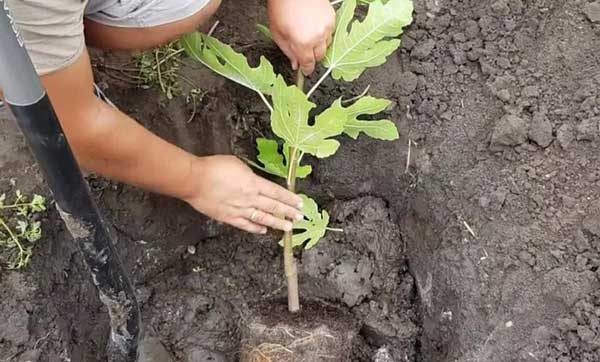
At the same time, some summer residents advise to deepen the seedling below the root collar by 10-15 cm, i.e. so that 2-3 buds are in the ground.
Landing in a pit (trench)
So that the figs are guaranteed not to freeze in winter, it is optimal to plant them in a pit (trench).
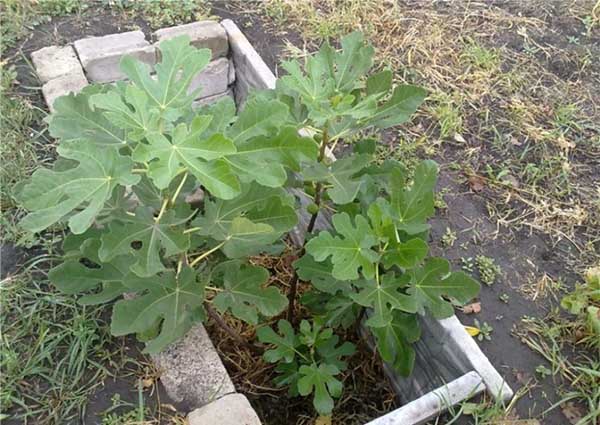
By the way! It is much better if there is also a greenhouse (greenhouse) above the trench.
Why is it ideally preferable to grow figs in the Middle Lane in a pit?
The fact is that it is much easier to cover and bend the shoots this way. In fact, the bushes will be in the basement, where the temperature will definitely not drop too low (assuming proper dry shelter) and the shoots will not freeze. Thus, this will be a guarantee that the not frozen earth will save you from negative temperatures.
What dimensions should a suitable trench be?
A depth of at least 30, and preferably all 50-60 centimeters, 50-60 wide and 2-3 meters long.
For more information on the nuances of planting and growing figs in a trench (pit), see the video below.
Video: growing figs in a pit
How to care for figs outdoors
In fact, figs require minimal maintenance - mostly just watering and proper shelter for the winter.
Make sure that the bush is not too thickened, then all branches and fruits will receive enough sunlight.
So, if you planted a fig seedling in the spring, then you will need to water regularly (every week), as well as loosen and weed the weeds from the near-trunk circle, and properly cover it for the winter in the fall.
If planted in the fall, then just monitor the humidity (if the fall is dry, water it a couple of times) and be sure to carefully cover.
Watering
Despite the fact that the fig is considered a drought-resistant plant, it requires moderate moisture supply, in other words, watering is one of the main agrotechnical measures for its cultivation.
The fact is that the root system of figs, its most part, is located in the upper layers of the soil (at a depth of 40 cm), and its drying out can lead to negative consequences: the leaves will begin to turn yellow and fall off, the fruits will not fill (ripen).
Therefore, in the dry, usually summer months, figs should be watered periodically (at least 1-2 times a month).
That is why they begin to water the figs in May and stop in July-August, when the fruits are poured and ripen.
With a lack of moisture, the yield decreases somewhat, and with an excess, the fruits lose their sweetness, begin to deteriorate quickly, and turn sour.
Shaping and pruning
As a rule, immediately after planting, the figs need to be trimmed and shaped.
To make the figs convenient to cover for the winter, it is best to shape them. in the form of a bush (i.e. use bush formation).
In the warm southern regions (on the Black Sea coast), of course, figs can be grown in the form of a tree.
So, if you decide to form a fig in the form of a bush, then immediately after planting it must be cut off at a height of 10-15 cm from the soil surface, leaving 3-4 buds, which will later become the main skeletal branches of the bush and fruiting shoots will grow on them.
Advice! It is very convenient to grow figs in a shape horizontal cardon, i.e. pruning (shaping) like grapes.
The creeping fig shape can be created in another way. Namely, initially cut off by 25-30 cm, later, after new shoots are formed from the buds, leave only the lowest ones and immediately bend them to the ground in different directions. Cut the upper part of the trunk completely and cover it with garden pitch. As a result, the bush forms an arachnoid shape.
Also, don't forget about sanitary and thinning scraps. Namely, remove damaged, dry, weak and excess branches (make sure that the bushes do not thicken).
Note! Figs bear fruit on shoots
last and current year, therefore needs annual pruning,
like grapes.
Concerning timing, then the annual pruning of figs is carried out in autumn (before shelter) and / or in spring (before the start of sap flow)... In this case, it is advisable to cover the cuts with garden pitch, since they do not overgrow well, and the entire branch can dry out.
Preparing figs for winter: autumn pruning and shelter
This is perhaps the most important ingredient in successful fig growing.
Therefore, we suggest that you familiarize yourself with a separate article, which describes the basic rules autumn care and proper preparation of figs for winter.
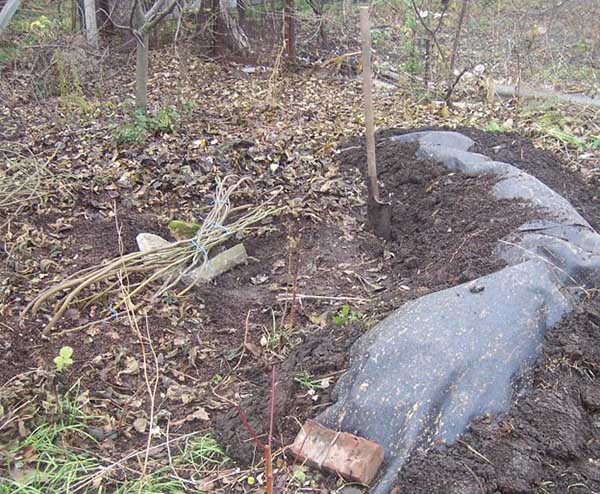
Of course, in the spring it is necessary to open the fig bushes in a timely manner (as a rule, they are fully opened only after the threat of frost has passed)
Well, figs can indeed be grown even in mid-latitudes. It will be quite difficult to do this, but it is quite possible, especially in a trench, greenhouse or greenhouse. If you do everything right, then the figs will surely respond to your concern not only with their decorative beauty, but also with magnificent fruits.
Video: features of planting, care and reproduction of figs

